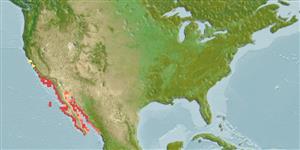Common names from other countries
Environment: milieu / climate zone / depth range / distribution range
Ecología
marino bentopelágico; no migratorio; rango de profundidad 2 - 30 m (Ref. 9310), usually 2 - 6 m (Ref. 9310). Subtropical; 0°C - 33°C (Ref. 35682); 38°N - 23°N, 125°W - 106°W
Eastern Central Pacific: San Francisco in California, USA to southern Baja California, Mexico.
Tamaño / Peso / Age
Maturity: Lm ? range ? - ? cm
Max length : 66.0 cm TL macho / no sexado; (Ref. 2850); edad máxima reportada: 10 años (Ref. 56049)
A resident intertidal species with homing behavior (Ref. 32612). Can leave tide pools if aquatic conditions become inhospitable (Ref. 31184). Also found near or over rocks and in kelp beds up to about 30 m depth. Feed mainly on seaweed, occasionally takes invertebrates. Form dense schools in spring in kelp beds. Pelagic spawner (Ref. 56049). Breathe air when out of water (Ref. 31184). Considered an important game fish and may incidentally be caught in commercial fishing activities (Ref. 9310). Marketed fresh (Ref. 9310).
Pelagic spawner (Ref. 56049).
Eschmeyer, W.N., E.S. Herald and H. Hammann, 1983. A field guide to Pacific coast fishes of North America. Boston (MA, USA): Houghton Mifflin Company. xii+336 p. (Ref. 2850)
IUCN Red List Status (Ref. 130435)
CITES (Ref. 128078)
Not Evaluated
Threat to humans
Harmless
Human uses
Pesquerías: comercial; pesca deportiva: si
Herramientas
Special reports
Download XML
Fuentes de Internet
Estimates based on models
Preferred temperature (Ref.
115969): 15.4 - 24.2, mean 22.3 (based on 112 cells).
Phylogenetic diversity index (Ref.
82804): PD
50 = 0.5000 [Uniqueness, from 0.5 = low to 2.0 = high].
Bayesian length-weight: a=0.01698 (0.00949 - 0.03040), b=3.15 (2.99 - 3.31), in cm Total Length, based on LWR estimates for this species & (Sub)family-body (Ref.
93245).
Nivel trófico (Ref.
69278): 2.0 ±0.00 se; based on food items.
Resiliencia (Ref.
120179): Medio, población duplicada en un tiempo mínimo de 1.4-4.4 años (tm=2.5; tmax=10).
Fishing Vulnerability (Ref.
59153): Moderate to high vulnerability (46 of 100).
Climate Vulnerability (Ref.
125649): High to very high vulnerability (70 of 100).
